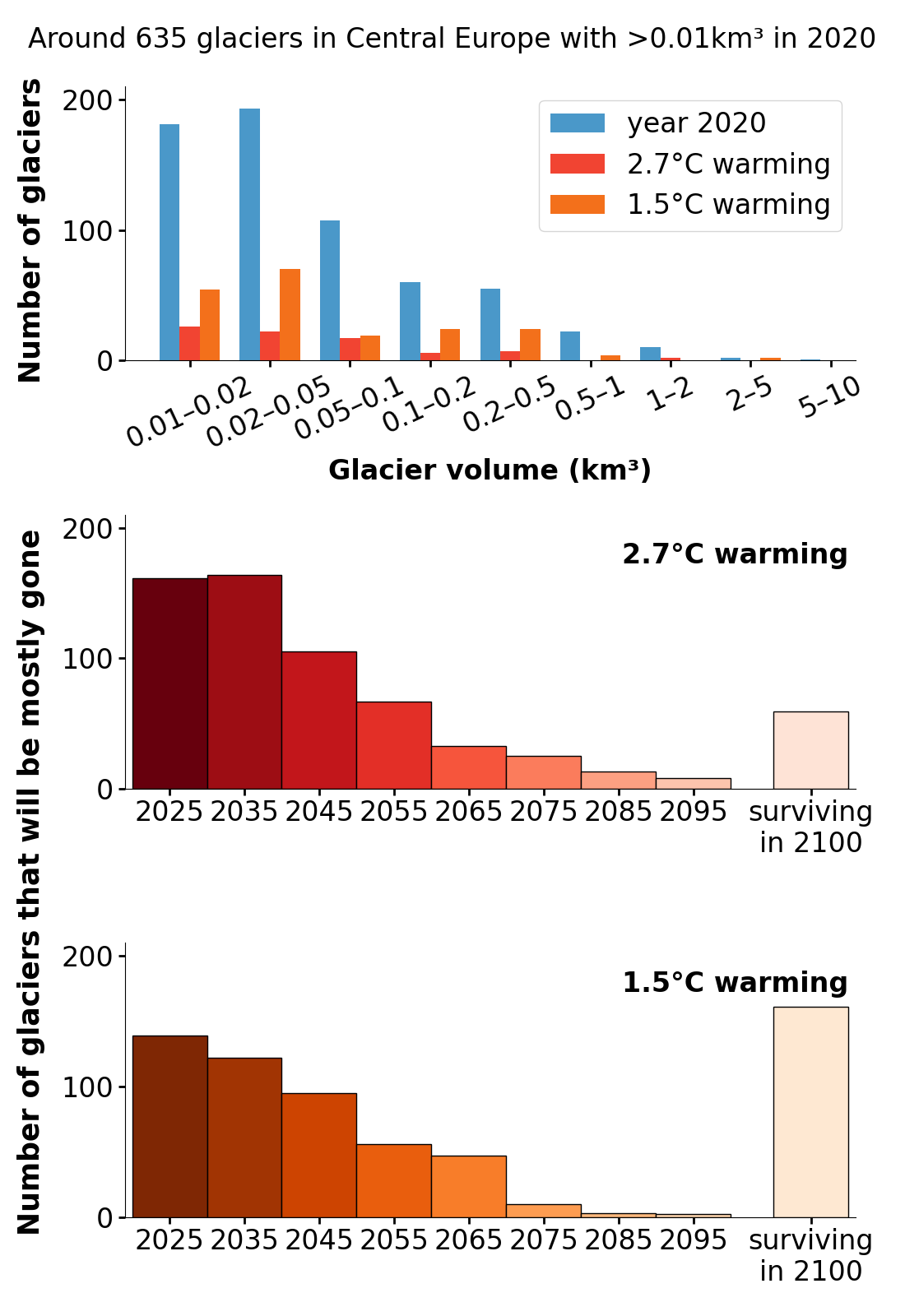With
current policy leading to a warming of 2.7°C, we are sadly saying
goodbye to many glaciers in the Alps. However, every tenth of a degree
reduced in warming can help preserve
glacier ice worldwide
and mitigate the impacts of climate change!
Below, you can select a listed glacier to see what its future might look like.
List by Country
- Hallstätter Gletscher, mostly gone by 2049
- Pasterze, mostly gone by 2063
- Schlaten Kees, 10% surviving in 2100
- Ködtnitzkees, mostly gone by 2031
- Tuxer Ferner, mostly gone by 2055
- Hornkees, mostly gone by 2049
- Sulztal Ferner, mostly gone by 2045
- Daunkogel Ferner, mostly gone by 2033
- Sulzenau Ferner, mostly gone by 2054
- Seekarlesferner, mostly gone by 2033
- Mittelbergferner, mostly gone by 2054
- Taschachferner, mostly gone by 2074
- Vernagtferner, mostly gone by 2042
- Gepatschferner, mostly gone by 2069
- Gaisbergferner, mostly gone by 2039
- Gurgler Ferner, mostly gone by 2048
- Hintereisferner, mostly gone by 2048
- Athabasca, 22% surviving in 2100
- White Glacier, 65% surviving in 2100
- Universidad, 16% surviving in 2100
- Glaciar San Francisco, mostly gone by 2059
- Glacier d'Argentière, mostly gone by 2065
- Mer de Glace, 27% surviving in 2100
- Glacier du Vallonnet, mostly gone by 2052
- Glacier de la Grande Motte, mostly gone by 2057
- Gebroulaz, mostly gone by 2062
- Glacier Blanc, mostly gone by 2061
- Schneeferner, mostly gone by 2030
- Äusseres Lahner Kees, mostly gone by 2031
- Gliderferner - Ghiacciaio del Gran Pilastro, mostly gone by 2040
- Ghiacciaio di Malavalle, mostly gone by 2052
- Ghiacciaio della Vallelunga, mostly gone by 2059
- Oberer Ortlerferner, mostly gone by 2064
- Madatschferner / Vedretta del Madaccio, mostly gone by 2053
- Niederer Ortlerferner, mostly gone by 2060
- Ghiacciaio del Careser, mostly gone by 2042
- Ghiacciaio de la Mare, mostly gone by 2051
- Forni, mostly gone by 2058
- Scerscen superiore, mostly gone by 2051
- Ventina, mostly gone by 2100
- Pisgana, mostly gone by 2044
- Marmolada, mostly gone by 2034
- Abramov, mostly gone by 2091
- Brewster Glacier, mostly gone by 2095
- Riukojietna / Rivgojiehkki, mostly gone by 2085
- Rabots Glaciär, mostly gone by 2066
- Mårma / Moarrhmmá, mostly gone by 2067
- Storglaciären, mostly gone by 2087
- Silvrettagletscher, mostly gone by 2048
- Clariden, mostly gone by 2051
- Steingletscher, 11% surviving in 2100
- Rhone, mostly gone by 2073
- Eigergletscher, 26% surviving in 2100
- Grosser Aletschgletscher, 12% surviving in 2100
- Fieschergletscher, mostly gone by 2095
- Oberaargletscher, mostly gone by 2053
- Tschingelfirn, mostly gone by 2056
- Kanderfirn, mostly gone by 2053
- Mittelaletschgletscher, mostly gone by 2075
- Vadret da Morteratsch, 16% surviving in 2100
- Vadret da Tschierva, 12% surviving in 2100
- Vadret da Palü, 11% surviving in 2100
- Turtmann, 17% surviving in 2100
- Brunegggletscher, mostly gone by 2073
- Glacier du Mont Miné, mostly gone by 2083
- Findelen, mostly gone by 2069
- Gorner- und Monte Rosa-Gletscher, 29% surviving in 2100
- Gulkana Glacier, mostly gone by 2084
Austria
Canada
Chile
France
Germany
Italy
Kyrgyzstan
New Zealand
Sweden
Switzerland
USA
Statistics for the Alps
Of the approximately 3,900 glaciers in the Alps in Central Europe, only
around 635 have an estimated volume above 0.01 km³ as of 2020, equivalent
to water stored in 4,000 Olympic-sized swimming pools.
We define 'mostly gone' as the year when either less than 10% of the glacier's 2020 volume or less than 0.01 km³ is expected to be left - whichever threshold is crossed first. Past either of these thresholds, the glacier will no longer be perceived as the glacier it once was.
Under 2.7°C warming, more than 577 (91%) glaciers in the Alps are estimated to be mostly gone before 2100.
Under 1.5°C warming, 103 of these 577 glaciers are expected to survive.
We define 'mostly gone' as the year when either less than 10% of the glacier's 2020 volume or less than 0.01 km³ is expected to be left - whichever threshold is crossed first. Past either of these thresholds, the glacier will no longer be perceived as the glacier it once was.
Under 2.7°C warming, more than 577 (91%) glaciers in the Alps are estimated to be mostly gone before 2100.
Under 1.5°C warming, 103 of these 577 glaciers are expected to survive.

